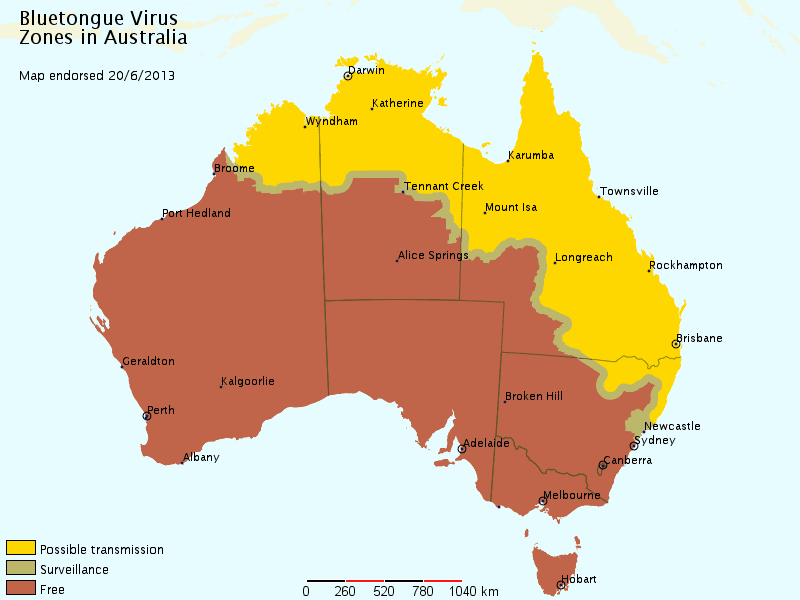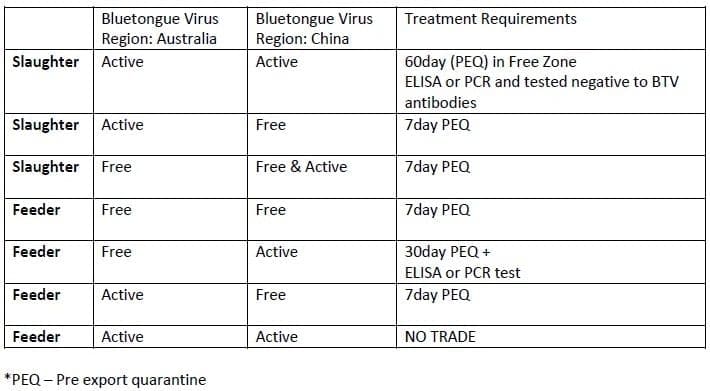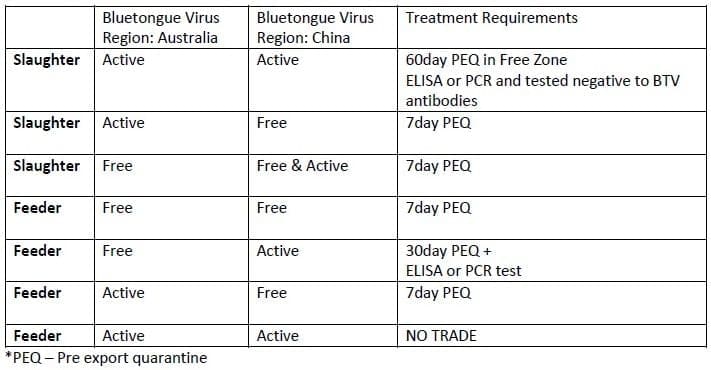How can I get into the Chinese cattle market? Who do I contact?
Exporting Australian livestock to any market requires a livestock export license issued by the Australian Government. Conditions on the type and preparation of cattle also apply. Cattle producers seeking to sell cattle for the China market should contact their agent or licensed exporter for further information.
Will China be required to comply with the Exporter Supply Chain Assurance System (ESCAS)?
All exporters will be required to establish post arrival supply chains, which involves independent auditing of facilities under the rules of the (ESCAS). More information on the rules relating to liveexports is available at http://www.agriculture.gov.au/export/live-animals/livestock
What type of cattle does China want? Feeder and/or slaughter? Bos Indicus or Bos Taurus? Breed, weight, age, fatness, sex, dentition, etc
The protocol allows for both feeder and slaughter cattle under certain conditions. Once exporters finalise commercial arrangements and start preparing for exporting, there will be more
information available about the particular specifications including breeds, age, sex, etc required.
How many cattle will China import in the next 12 months?
Until commercial arrangements with customers and supply chains are established and the trade commences, it is too difficult to speculate on the numbers that will be exported to China.
When will exporters start buying cattle for China?
Exporters still have some work to do before the trade can commence. This includes finalising commercial arrangements with potential customers and establishing supply conditions that meet Australian and Chinese regulatory requirements.
How long is the voyage to China?
The voyage from Australia to China is estimated to be between 8 and 25 days, depending on the port of departure and destination.
What ports will the cattle go to?
It will be a matter for Chinese authorities to determine which ports will be approved to receive cattle shipments and this will become clearer as the trade matures.
What ports will the cattle go from?
The health protocol has been negotiated to enable access for cattle from anywhere in Australia, however, there are specific requirements that must be met when sourcing from various regions. This may make some regions less commercially attractive than others, regardless, the trade could be open for new opportunities for cattle from northern and southern ports including major export ports of Portland, Adelaide, Fremantle, Darwin, and Townsville but also ports such as Broome, Karumba and Wyndham.
Can I sell cattle from the north or south or both?
The protocol provides access, subject to the conditions specified, for cattle from across Australia. For further details, contact your agent or exporter.
What is bluetongue (BTV) and why is it important?
Bluetongue is an insect borne, non-contagious viral disease (primarily of sheep). The virus comes in many different serotypes (or variations), some of which cause clinical disease in some countries and others which have no affect on the animal, as is the case in Australia. While the virus is present in regions of Australia (mainly the north), it does not cause clinical disease in our livestock populations. However, because the disease can be a significant animal health issue in other countries it remains a sensitivity within the global livestock trade. This can lead importing countries to avoid sourcing from countries where the disease or virus is present or requiring additional measures such as testing or vaccination.
What’s the story with the Blue Tongue Virus Zone and how does it impact cattle eligibility for China?
The agreed feeder/slaughter cattle protocol uses the presence or absence of the bluetongue virus in different regions of Australia and China to differentiate on the risk management measures required. Further detail on Australia’s bluetongue virus zone is available at www.namp.animalhealthaustralia.com.au. The specific requirements of the agreed protocol as they relate to the bluetongue virus regions are as follows:
Additional requirements for all cattle:
- Cattle individually inspected by Government approved veterinarian in Registered Premises before commencement of PEQ.
- Cattle have not been treated with HGPs.
- Cattle treated for external parasites in PEQ, with cattle exported from the cattle tick infected zone plunge dipped.
- Cattle must be resident on the farm of origin for 3 months.
- Cattle for export must not be “cull animals” (e.g must not be old / poor conditioned animals) and must not be pregnant.
- Cattle are to be prepared in Registered Premises on an all in all out basis (one consignee). No other livestock can be held on the premises during the preparation of a consignment.
- Slaughter cattle must be processed within 14 days and feeder cattle within three months of arriving in China (importer responsibility).
- The bluetongue virus regions of Australia and China will be based on each country’s respective bluetongue virus or vector monitoring programs. Further information on the Australian system is available at www.namp.animalhealthaustralia.com.au
- Bluetongue virus does not cause clinical disease in Australian livestock populations.
What health specs do I need to meet? Will my cattle need to be treated or tested for anything?
The protocol does require certain treatments and tests as well as pre-export quarantine prior to shipping. You can expect to get the details from your agents and exporters. As is the case with all livestock destined for the live trade, it is critically important that all instructions are followed to the required detail.
Can I use HGP’s on cattle destined for the China market?
No. Cattle treated with HGPs are specifically excluded from the market under the health protocol.
What are the facilities like in China? Will my cattle be looked after?
Welfare of livestock is an important part of Australia’s commercial arrangements for live export. Australian exporters have been active in working with potential customers and sourcing feedlots and abattoirs that will be able to cater for the handling and slaughter requirements for Australian cattle. This includes the use of stunning. Under Australian Government regulations, cattle can only enter approved feedlots and abattoirs that meet international animal welfare standards, are overseen by Australian exporters and are regularly audited by 3rd party accredited auditors. This system applies to all markets and will also apply to supply chains in China. Australian exporters will also provide training and support infrastructure improvements where required.
Will China take the cattle that Indonesia has essentially rejected by reducing quota for Q3?
There is potential for feeder cattle from northern Australia to be exported to China, however the success of the feeder trade from northern Australia will be subject to the commercial demand.
Australia – China feeder and slaughter cattle health Protocol summary
The agreed health protocol for the export of feeder and slaughter cattle from Australia to the People’s Republic of China has detailed requirements that must be met by the licensed exporter. This document summarises the key requirements of the protocol.
Additional requirements for all cattle:
- Cattle individually inspected by Government approved veterinarian in Registered Premises before commencement of PEQ.
- Cattle have not been treated with HGPs.
- Cattle treated for external parasites in PEQ, with cattle exported from the cattle tick infected zone plunge dipped.
- Cattle must be resident on the farm of origin for 3 months.
- Cattle for export must not be “cull animals” (e.g must not be old / poor conditioned animals) and must not be pregnant.
- Cattle are to be prepared in Registered Premises on an all in all out basis (one consignee). No other livestock can be held on the premises during the preparation of a consignment.
- Slaughter cattle must be processed within 14 days and feeder cattle within three months of arriving in China (importer responsibility).
- The bluetongue virus regions of Australia and China will be based on each country’s respective bluetongue virus or vector monitoring programs. Further information on the Australian system is available at www.namp.animalhealthaustralia.com.au
- Bluetongue virus does not cause clinical disease in Australian livestock populations.






Sending live export to China now! Makes me shudder. Refrigeration isn’t a problem in China so please have a heart people and send chilled boxed beef instead.
It’s a sad day when Australia has put in place an agreement with a country whose animal welfare standards are among the worst in the world. And forget ESCAS.. it isn’t worth the paper it’s written on when there have been no charges laid for any breaches.
In ten years of exporting live cattle from three ports in Australia (Geelong, Portland and Fremantle) to 12 ports in China, not one voyage has ever taken eight days and only one was a single digit figure – Geelong to Tianjin in 2011 (9 days). The average voyage length is 19 days, with 32 voyages lasting 20-29 days and three taking in excess of 30 days.
This government has no soul, no compassion, no care or consideration for Australian jobs and as repeatedly demonstrated (but never as clearly as now), couldn’t give a flying **** for animal welfare.